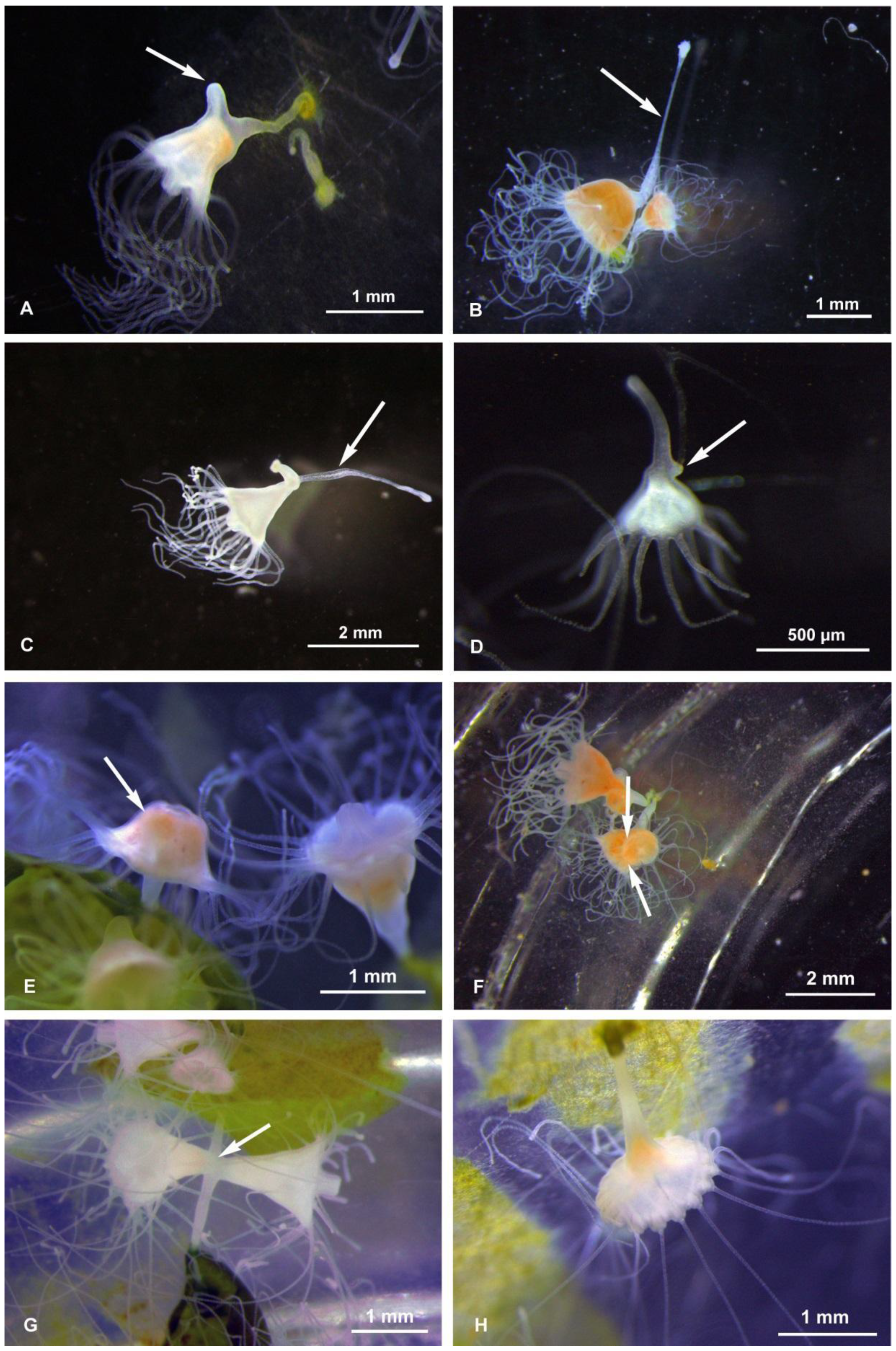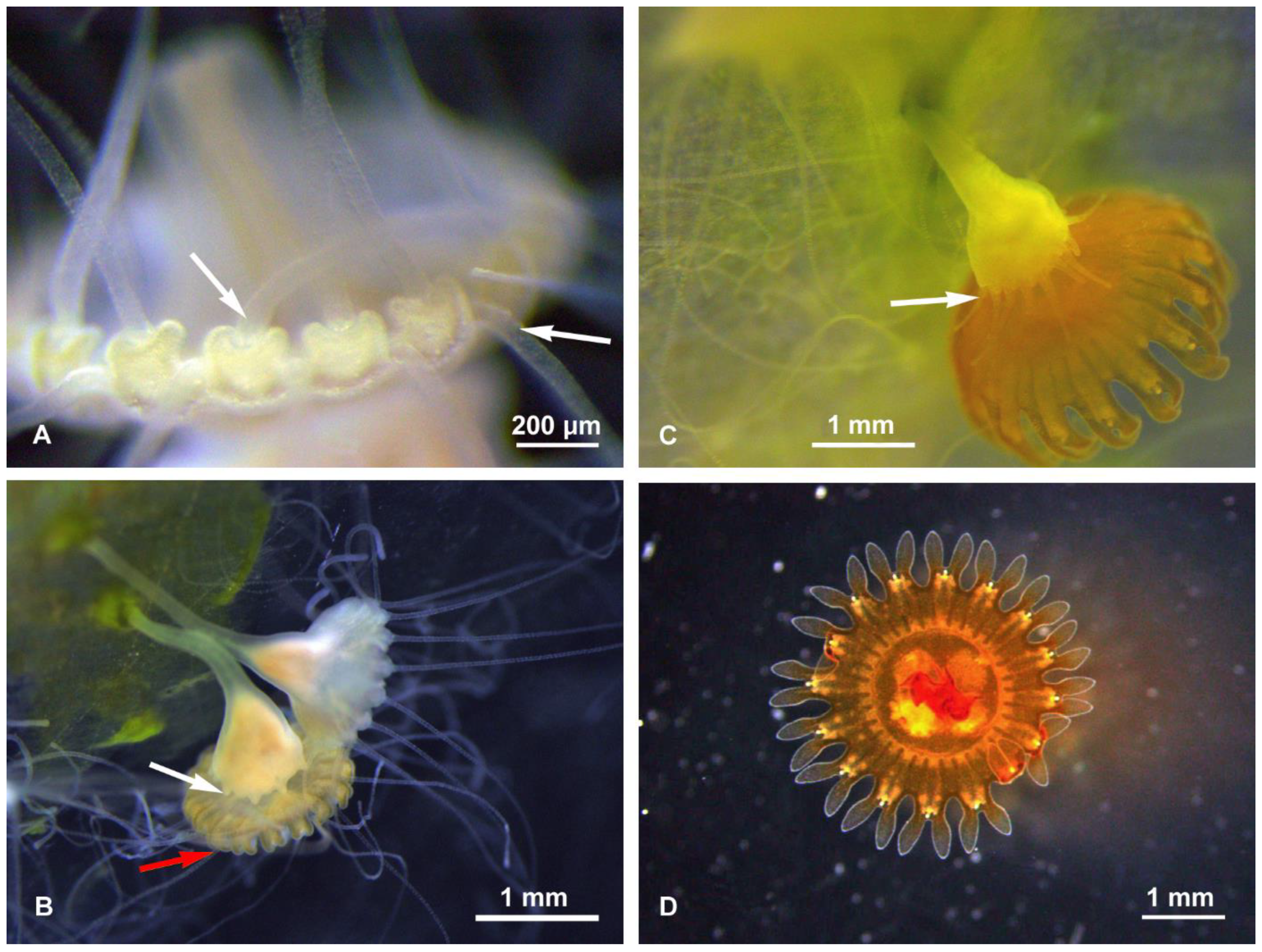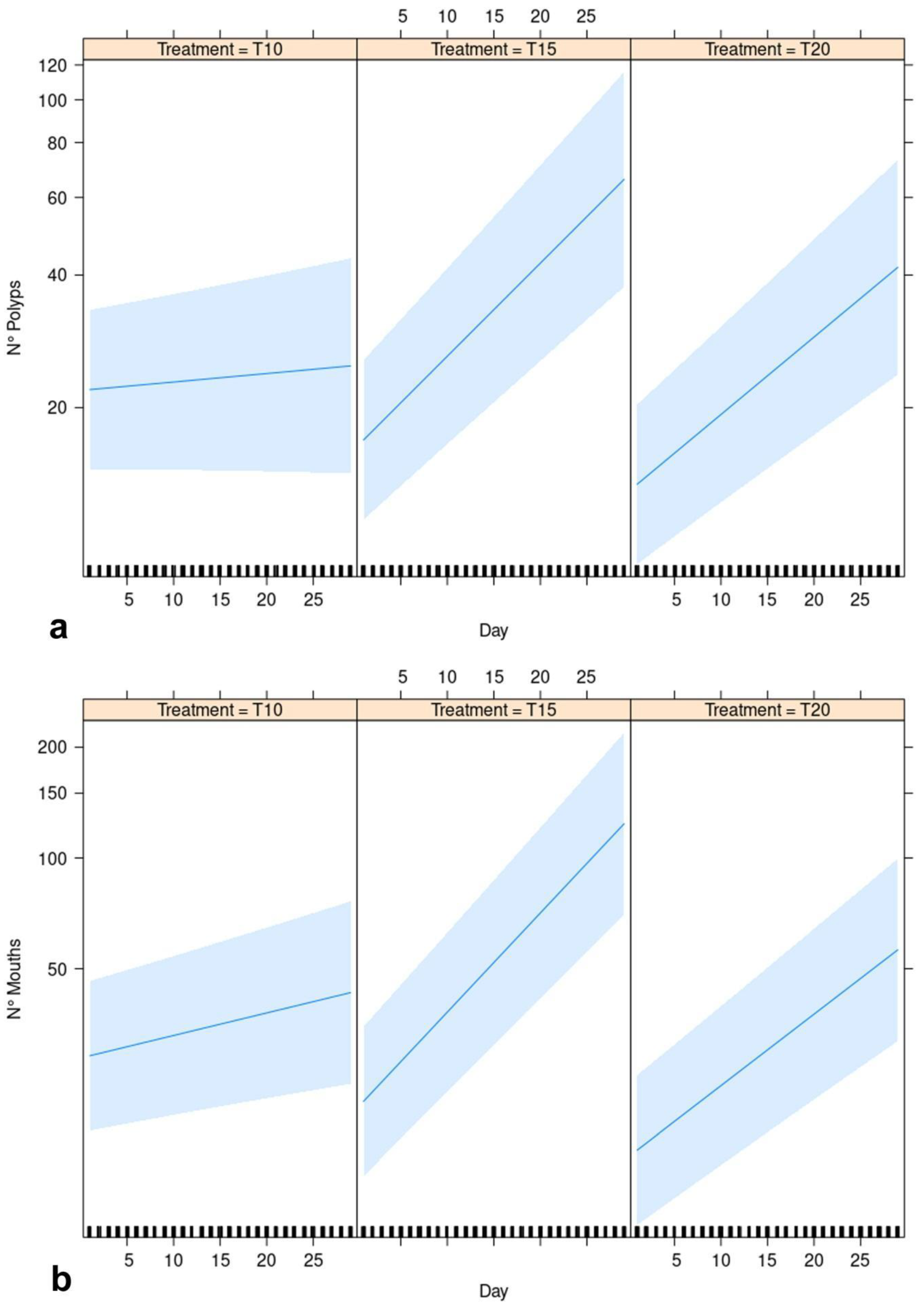Asexual Reproduction and Strobilation of Sanderia malayensis (Scyphozoa, Pelagiidae) in Relation to Temperature: Experimental Evidence and Implications
Abstract
1. Introduction
2. Materials and Methods
2.1. Cultivation of Sanderia malayensis and Aurelia solida Polyps
2.2. Sanderia Budding at Different Temperatures
2.3. Predation: S. malayensis vs. A. solida Ephyrae
2.4. Statistical Analysis
3. Results
3.1. Budding Rate at Different Temperatures
3.2. Predation: S. malayensis vs. A. solida Ephyrae
4. Discussion
Supplementary Materials
Author Contributions
Funding
Institutional Review Board Statement
Informed Consent Statement
Data Availability Statement
Acknowledgments
Conflicts of Interest
References
- Licandro, P.; Conway, D.V.P.; Daly Yahia, M.N.; Fernandez de Puelles, M.L.; Gasparini, S.; Hecq, J.H.; Tranter, P.; Kirby, R.R. A blooming jellyfish in the northeast Atlantic and Mediterranean. Biol. Lett. 2010, 6, 688–691. [Google Scholar] [CrossRef]
- Lynam, C.P.; Lilley, M.K.S.; Bastian, T.; Doyle, T.K.; Beggs, S.E.; Hays, G.C. Have jellyfish in the benefited from climate change and overfishing? Glob. Chang. Biol. 2011, 17, 767–782. [Google Scholar] [CrossRef]
- Brotz, L.; Cheung, W.W.; Kleisner, K.; Pakhomov, E.; Pauly, D. Increasing jellyfish populations: Trends in large marine ecosystems. Hydrobiologia 2012, 690, 3–30. [Google Scholar] [CrossRef]
- Condon, R.H.; Duarte, C.M.; Pitt, K.A.; Robinson, K.L.; Lucas, C.H.; Sutherland, K.R.; Mianzan, H.W.; Bogeberg, M.; Purcell, J.E.; Decker, M.B.; et al. Recurrent jellyfish blooms are a consequence of global oscillations. Proc. Nat. Acad. Sci. USA 2013, 110, 1000–1005. [Google Scholar] [CrossRef]
- Kogovšek, T.; Bogunović, B.; Malej, A. Recurrence of bloom-forming scyphomedusae: Wavelet analysis of a 200-year time series. Hydrobiologia 2010, 645, 81–96. [Google Scholar] [CrossRef]
- D’Ambra, I.; Malej, A. Scyphomedusae of the Mediterranean: State of the art and future perspectives. Cent. Nerv. Syst. Agents Med. Chem. 2015, 15, 81–94. [Google Scholar] [CrossRef]
- Gravili, C. Jelly surge in the Mediterranean Sea: Threat or opportunity? Med. Mar. Sci. 2020, 21, 11–21. [Google Scholar] [CrossRef]
- Pierson, J.; Camatti, E.; Hood, R.; Kogovšek, T.; Lučić, D.; Tirelli, V.; Malej, A. Mesozooplankton and gelatinous zooplankton in the face of environmental stressors. In Coastal Ecosystems in Transition: A Comparative Analysis of the Northern Adriatic and Chesapeake Bay; Malone, T., Malej, A., Faganeli, J., Eds.; American Geophysical Union: Washington, DC, USA, 2021. [Google Scholar] [CrossRef]
- Graham, W.M.; Gelcich, S.; Robinson, K.L.; Duarte, C.M.; Brotz, L.; Purcell, J.E.; Pitt, K.A. Linking human well-being and jellyfish: Ecosystem services, impacts, and societal responses. Front. Ecol. Environ. 2014, 12, 515–523. [Google Scholar] [CrossRef]
- Palmieri, M.G.; Barausse, A.; Luisetti, T.; Turner, K. Jellyfish blooms in the Northern Adriatic Sea: Fishermen’s perceptions and economic impacts on fisheries. Fish. Res. 2014, 155, 51–58. [Google Scholar] [CrossRef]
- Mills, C.E. Jellyfish blooms: Are populations increasing globally in response to changing ocean conditions? Hydrobiologia 2001, 451, 55–68. [Google Scholar] [CrossRef]
- Miyake, H.; Hashimoto, J.; Chikuchishin, M.; Miura, T. Scyphopolyps of Sanderia malayensis and Aurelia aurita attached to tubes of vestimentiferan tubeworm (Lamellibrachia satsuma) at submarine fumaroles in Kagoshima Bay. Mar. Biotechnol. 2004, 6, S174–S178. [Google Scholar] [CrossRef]
- Duarte, C.M.; Pitt, K.A.; Lucas, C.H.; Purcell, J.E.; Uye, S.I.; Robinson, K.; Madin, L.P.; Mianzan, H.; Sutherland, K.R.; Uye, S.; et al. Is global ocean sprawl a cause of jellyfish blooms? Front. Ecol. Environ. 2013, 11, 91–97. [Google Scholar] [CrossRef]
- Lucas, C.H.; Graham, W.M.; Widmer, C. Jellyfish life histories: Role of polyps in forming and maintaining scyphomedusa populations. Adv. Mar. Biol. 2012, 63, 133–196. [Google Scholar] [CrossRef] [PubMed]
- Jarms, G.; Morandini, A.C.; Schmidt-Rhaesa, A.; Giere, O.; Straehler-Pohl, I. World Atlas of Jellyfish: Scyphozoa except Stauromedusae; Jarms, G., Morandini, A.C., Eds.; Dölling und Galitz Verlag: Hamburg, Germany, 2019; pp. 324–377. [Google Scholar]
- Goette, A.; der Medusen welche, V. Stabsarzt Auf S.M.S. “Prinz Adalbert” Gesammelt Wurden. Sitzungsberichte der Preussischen Stabsarzt auf S.M.S. “Prinz Adalbert” Gesammelt Wurden; Sitzungsberichte der Preussischen Königlichen Akademie der Wissenschaften: Berlin, Germany, 1886; Volume 2, pp. 831–837. [Google Scholar]
- Mayer, A.G. Medusae of the World: The Scyphomedusae; Carnegie Institution of Washington: Washington, DC, USA, 1910; Volume III, p. 735. [Google Scholar]
- Uchida, T. Distribution of Scyphomedusae in Japanese and its adjacent waters. J. Fac. Sci. Hokkaido Univ. Ser. VI Zool. 1954, 12, 209–219. [Google Scholar]
- Kramp, P.L. Synopsis of the medusae of the world. J. Mar. Biol. Assoc. UK 1961, 40, 7–382. [Google Scholar] [CrossRef]
- Fenner, P.J.; Williamson, J.A. Worldwide deaths and severe envenomation from jellyfish stings. Med. J. Australia 1996, 165, 658–661. [Google Scholar] [CrossRef] [PubMed]
- Uchida, T. Medusae in the vicinity of the Amakusa Marine Biological Station. Bull. Biogeogr. Soc. Japan 1938, 8, 143–149. [Google Scholar]
- Uchida, T.; Sugiura, Y. On the polyp of the Scyphomedusa, Sanderia malayensis and its reproduction. J. Fac. Sci. Hokkaido Univ. Ser. VI Zool. 1978, 21, 279–286. [Google Scholar]
- Adler, L.; Jarms, G. New insights into reproductive traits of scyphozoans: Special methods of propagation in Sanderia malayensis Goette, 1886 (Pelagiidae, Semaeostomeae) enable establishing a new classification of asexual reproduction in the class Scyphozoa. Mar. Biol. 2009, 156, 1411–1420. [Google Scholar] [CrossRef]
- Straehler-Pohl, I.; Widmer, C.L.; Morandini, A.C. Characterizations of juvenile stages of some semaeostome Scyphozoa (Cnidaria), with recognition of a new family (Phacellophoridae). Zootaxa 2011, 2741, 1–37. [Google Scholar] [CrossRef]
- Schiariti, A.; Morandini, A.C.; Jarms, G.; von Glehn Paes, R.; Franke, S.; Mianzan, S. Asexual reproduction strategies and blooming potential in Scyphozoa. Mar. Ecol. Prog. Ser. 2014, 510, 241–253. [Google Scholar] [CrossRef]
- Uchida, T.; Sugiura, Y. On the ephyra and postephyra of Semaeostome medusa, Sanderia malayensis Goette, 1886. J. Fac. Sci. Hokkaido Univ. Ser. VI Zool. 1975, 19, 879–881. [Google Scholar]
- Straehler-Pohl, I.; Jarms, G. Identification key for young ephyrae: A first step for early detection of jellyfish blooms. In Jellyfish Blooms: New Problems and Solutions; Purcell, J.E., Dror, A., Eds.; Springer: Dordrecht, The Netherlands, 2015. [Google Scholar]
- Morandini, A.C.; Gul, S. Rediscovery of Sanderia malayensis and remarks on Rhopilema nomadica record in Pakistan (Cnidaria: Scyphozoa). Pap. Avulsos Zool. 2016, 56, 171–175. [Google Scholar] [CrossRef]
- Browne, E.T. Zoological results of the Cambridge Expedition to the Suez Canal, 1924. Trans. Zool. Soc. Lond. 1926, 22, 105–115. [Google Scholar] [CrossRef]
- Agatha, S.; Strüder-Kypke, M.C.; Beran, A. Morphologic and genetic variability in the marine planktonic ciliate Laboea strobila Lohmann, 1908 (Ciliophora, Oligotrichia), with notes on its ontogenesis. J. Eukaryot. Microbiol. 2004, 51, 267–281. [Google Scholar] [CrossRef] [PubMed]
- Purcell, J.E.; Atienza, D.; Fuentes, V.; Olariaga, A.; Tilves, U.; Colahan, C.; Gili, J.M. Temperature effects on asexual reproduction rates of scyphozoan species from the northwest Mediterranean Sea. Hydrobiologia 2012, 690, 169–180. [Google Scholar] [CrossRef]
- Bolker, B.M.; Brooks, M.E.; Clark, C.J.; Geange, S.W.; Poulsen, J.R.; Stevens, M.H.H.; White, J.S.S. Generalized linear mixed models: A practical guide for ecology and evolution. Trends Ecol. Evol. 2009, 24, 127–135. [Google Scholar] [CrossRef] [PubMed]
- Venables, W.N.; Ripley, B.D. Modern Applied Statistics with S., 4th ed.; Springer: New York, NY, USA, 2002. [Google Scholar] [CrossRef]
- Jaeger, B. R2glmm: Computes R Squared for Mixed (Multilevel) Models. R Package Version 0.1, 2. Available online: https://github.com/bcjaeger/r2glmm (accessed on 12 December 2020).
- R Core Team. R: A Language and Environment for Statistical Computing; R Foundation for Statistical Computing: Vienna, Austria, 2020. [Google Scholar]
- Anderson, M.J. A new method for non-parametric multivariate analysis of variance. Austral. Ecol. 2001, 26, 32–46. [Google Scholar] [CrossRef]
- Clarke, K.R.; Gorley, R.N. PRIMER v6: User Manual/Tutorial (Plymouth Routines in Multivariate Ecological Research); PRIMER-E: Plymouth, UK, 2006; p. 192. [Google Scholar]
- Hall, H.; Warmolts, D. The role of public aquariums in the conservation and sustainability of the marine ornamentals trade. In Marine Ornamental Species: Collection, Culture & Conservation; Cato, J.C., Brown, C.L., Eds.; Iowa State Press: Ames, IA, USA, 2003; ISBN 978-0813829876. [Google Scholar]
- Gershwin, L.A.; Zeidler, W. Two new jellyfishes (Cnidaria: Scyphozoa) from tropical Australian waters. Zootaxa 2008, 1764, 41–52. [Google Scholar] [CrossRef]
- Xian, W.; Kang, B.; Liu, R. Jellyfish blooms in the Yangtze Estuary. Science 2005, 307, 41. [Google Scholar] [CrossRef]
- Gershwin, L.A. Jellyfish: A Natural History; Ivy Press: East Sussex, UK, 2016; p. 224. [Google Scholar]
- Pascual, M.; Fuentes, V.; Canepa, A.; Atienza, D.; Gili, J.M.; Purcell, J.E. Temperature effects on asexual reproduction of the scyphozoan Aurelia aurita sl: Differences between exotic (Baltic and Red seas) and native (Mediterranean Sea) populations. Mar. Ecol. 2014, 36, 994–1002. [Google Scholar] [CrossRef]
- Morandini, A.C.; Silveira, F.L.D.; Jarms, G. The life cycle of Chrysaora lactea Eschscholtz, 1829 (Cnidaria, Scyphozoa) with notes on the scyphistoma stage of three other species. Hydrobiologia 2004, 530, 347–354. [Google Scholar] [CrossRef]
- Bayha, K.M.; Graham, W.M. Nonindigenous marine jellyfish: Invasiveness, invasibility, and impacts. In Jellyfish Blooms; Pitt, K.A., Lucas, C.H., Eds.; Springer Netherlands: Dordrecht, The Netherlands, 2014; pp. 45–77. ISBN 978-94-007-7015-7. [Google Scholar]
- Scorrano, S.; Aglieri, G.; Boero, F.; Dawson, M.N.; Piraino, S. Unmasking Aurelia species in the Mediterranean Sea: An integrative morphometric and molecular approach. Zool. J. Linn. Soc. 2016, 180, 243–267. [Google Scholar] [CrossRef]




| Treatment | Day | Replicates | Polyps | Mouth | Dead Polyps | Ephyrae Released |
|---|---|---|---|---|---|---|
| T10 | 1 | A | 52 | 83 | ||
| 39 | 72 | 172 | 0 | 4 | ||
| 1 | B | 19 | 26 | |||
| 39 | 24 | 38 | 2 | 2 | ||
| 1 | C | 17 | 21 | |||
| 39 | 20 | 30 | 1 | 6 | ||
| 1 | D | 10 | 14 | |||
| 39 | 12 | 22 | 4 | 0 | ||
| T15 | 1 | A | 38 | 44 | ||
| 39 | 130 | 215 | 0 | 2 | ||
| 1 | B | 25 | 28 | |||
| 39 | 100 | 171 | 0 | 0 | ||
| 1 | C | 12 | 16 | |||
| 39 | 38 | 66 | 0 | 5 | ||
| 1 | D | 11 | 17 | |||
| 39 | 41 | 89 | 1 | 1 | ||
| T20 | 1 | A | 19 | 33 | ||
| 39 | 78 | 100 | 0 | 1 | ||
| 1 | B | 16 | 25 | |||
| 39 | 60 | 80 | 0 | 1 | ||
| 1 | C | 12 | 12 | |||
| 39 | 24 | 38 | 1 | 1 | ||
| 1 | D | 11 | 14 | |||
| 39 | 36 | 50 | 0 | 1 |
| Variable N° Polyps | Chisq | Df | Pr (>Chisq) |
| Treatment | 80.148 | 2 | *** |
| Day | 226.774 | 1 | *** |
| Treatment × Day | 84.857 | 2 | *** |
| Variable N° Mouths | Chisq | Df | Pr (>Chisq) |
| Treatment | 58.468 | 2 | *** |
| Day | 515.677 | 1 | *** |
| Treatment × Day | 123.672 | 2 | *** |
| Source of Variation | Df | MS | Pseudo F | p-Value |
|---|---|---|---|---|
| Treatment | 2 | 42.04 | 19.43 | 0.004 |
| Residual | 9 | 19.46 | ||
| Total | 11 | 103.55 |
| Preys Ingested | |||||
|---|---|---|---|---|---|
| Time | Rep 1 | Rep 2 | Rep 3 | Only Aurelia | Only Sanderia |
| T0 | 0 | 0 | 0 | 0 | 0 |
| T10 | 1 | 0 | 1 | 0 | 0 |
| T20 | 2 | 0 | 2 | 0 | 0 |
| T30 | 1 * | 2 | 1 * | 0 | 0 |
| T40 | 0 | 0 | 0 | 0 | 0 |
| T50 | 0 | 0 | 0 | 0 | 0 |
| T60 | 0 | 0 | 0 | 0 | 0 |
| T70 | 0 | 0 | 0 | 0 | 0 |
| T80 | 0 | 0 | 0 | 0 | 0 |
| T90 | 0 | 0 | 0 | 0 | 0 |
| T100 | 0 | 0 | 0 | 0 | 0 |
| T110 | 0 | 0 | 0 | 0 | 0 |
| T120 | 0 | 0 | 0 | 0 | 0 |
Publisher’s Note: MDPI stays neutral with regard to jurisdictional claims in published maps and institutional affiliations. |
© 2021 by the authors. Licensee MDPI, Basel, Switzerland. This article is an open access article distributed under the terms and conditions of the Creative Commons Attribution (CC BY) license (http://creativecommons.org/licenses/by/4.0/).
Share and Cite
Avian, M.; Motta, G.; Prodan, M.; Tordoni, E.; Macaluso, V.; Beran, A.; Goruppi, A.; Bacaro, G.; Tirelli, V. Asexual Reproduction and Strobilation of Sanderia malayensis (Scyphozoa, Pelagiidae) in Relation to Temperature: Experimental Evidence and Implications. Diversity 2021, 13, 37. https://doi.org/10.3390/d13020037
Avian M, Motta G, Prodan M, Tordoni E, Macaluso V, Beran A, Goruppi A, Bacaro G, Tirelli V. Asexual Reproduction and Strobilation of Sanderia malayensis (Scyphozoa, Pelagiidae) in Relation to Temperature: Experimental Evidence and Implications. Diversity. 2021; 13(2):37. https://doi.org/10.3390/d13020037
Chicago/Turabian StyleAvian, Massimo, Gregorio Motta, Mattia Prodan, Enrico Tordoni, Vanessa Macaluso, Alfred Beran, Alenka Goruppi, Giovanni Bacaro, and Valentina Tirelli. 2021. "Asexual Reproduction and Strobilation of Sanderia malayensis (Scyphozoa, Pelagiidae) in Relation to Temperature: Experimental Evidence and Implications" Diversity 13, no. 2: 37. https://doi.org/10.3390/d13020037
APA StyleAvian, M., Motta, G., Prodan, M., Tordoni, E., Macaluso, V., Beran, A., Goruppi, A., Bacaro, G., & Tirelli, V. (2021). Asexual Reproduction and Strobilation of Sanderia malayensis (Scyphozoa, Pelagiidae) in Relation to Temperature: Experimental Evidence and Implications. Diversity, 13(2), 37. https://doi.org/10.3390/d13020037






